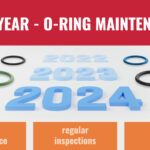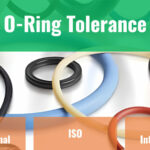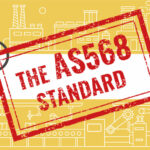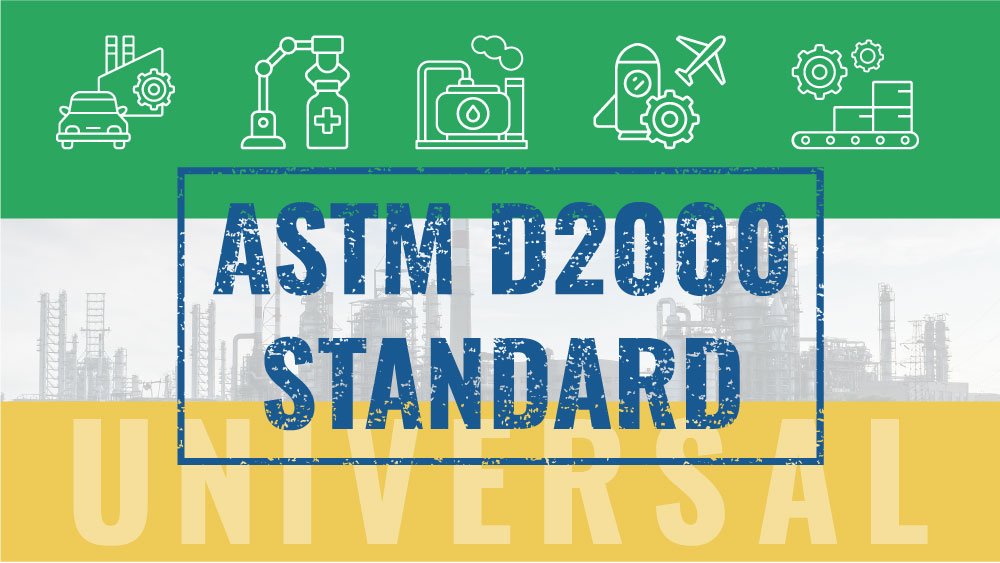
Summary
- ASTM D2000, a standard developed in the 1950s, significantly revolutionized the sealing industry by systematically classifying elastomeric materials.
- This standard aids in precise material selection, ensuring quality and reliability across industries and catalyzing innovation in the rubber industry.
- The ASTM D2000 also contributes to international cooperation, impacts the daily operations of numerous businesses, and provides a decision-making guide, leading to enhanced productivity and satisfaction for end users.
Introduction
Standards are the lifeblood of innovation, consistency, and quality. The ASTM D2000 is significant among these pivotal standards, especially in sealing compounds. In this post, we aim to define the significance and complexities of the ASTM D2000 standard, taking you through its origins, impact on material selection, broad scope, and profound implications for stakeholders in the sealing industry.
History and Development of ASTM D2000
In the aftermath of World War II, the escalating complexity of machinery and a surge in demand for dependable, uniform materials prompted the U.S. military to acknowledge the importance of standardization in manufacturing and using elastomeric sealing compounds. The ASTM Committee D11 on Rubber and Rubber-like Materials met this demand by devising a systematic classification for elastomeric materials. Their dedication culminated in creating the ASTM D2000 – Standard Classification System for Rubber Products in Automotive Applications during the 1950s.
The formulation of this standard was a product of collective genius, drawing upon the expertise of industry leaders, engineers, and scientists. Their mission extended beyond curbing industry confusion; they aimed to construct a universally accepted paradigm that fostered consistent innovation while upholding stringent reliability standards.
The Society of Automotive Engineers (SAE), an international authority on automotive standards, played a pivotal role in this undertaking. The SAE recognized the transformative potential of ASTM D2000 in offering a universal language for elastomer specifications, a vital need in an industry that was diversifying exponentially. The endorsement by the SAE amplified the standard’s credibility, paving the way for its broad acceptance across the automotive industry and various other sectors employing rubber products.
The establishment of the ASTM D2000 standard epitomized a milestone, forging a pathway toward a more unified and systematic industry. This standard clarified the vagueness that had previously clouded material selection, empowering manufacturers and end-users with a shared vocabulary for discussing the attributes and performance of sealing compounds.
In developing the ASTM D2000 standard, the committee showcased a deep comprehension of the multifaceted nature of elastomeric materials and their intricate applications. This understanding rendered the standard as a classification system and a chronicle of the evolution of elastomers and their diverse industrial uses over time. The lasting impact of the ASTM D2000 standard underscores the indispensability of systematic, standardized practices in industrial production.
Hence, the ASTM D2000 signified a paradigm shift for the industry. It dispelled uncertainties in material selection and unified manufacturers and end-users with a standard language when addressing the characteristics and performance of sealing compounds. The shared effort of the ASTM Committee and organizations like the SAE solidified the standard’s widespread acceptance and application, setting a new course for the industrial production sector.
ASTM D2000’s Influence on Consistency and Performance
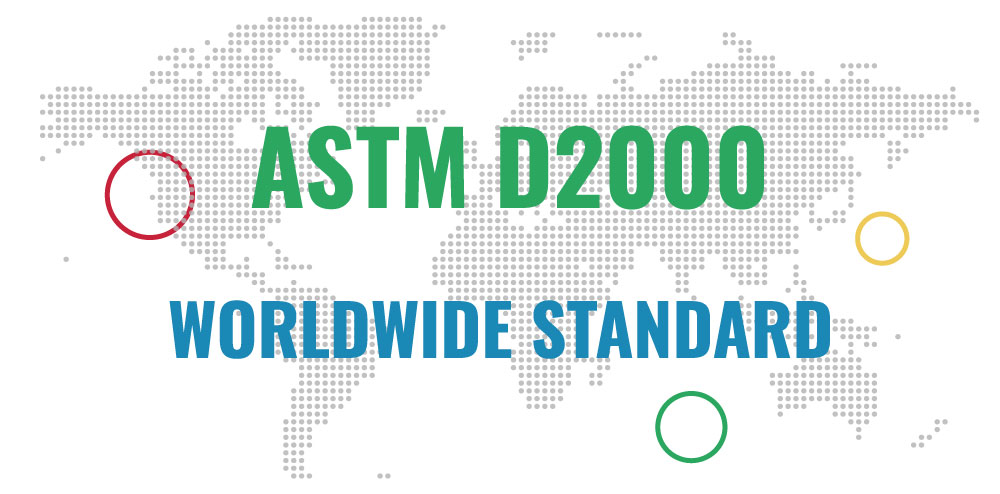
The ASTM D2000 outlines a classification system that categorizes materials based on their physical properties, heat aging, and resistance to some aspects like oil and ozone. This system is a critical link between manufacturers, suppliers, and end-users, ensuring everyone shares a common understanding of each elastomer’s properties and performance characteristics.
Moreover, the standard doesn’t merely list the properties; it sets specific benchmarks each elastomer must meet to fall within a particular classification. This classification process has transformed the industry, leading to remarkable consistency and performance. Manufacturers now have a clear roadmap to follow, and end-users can rest assured knowing that their sealing compounds will perform reliably in their intended applications.
By setting specific performance requirements, the ASTM D2000 helps maintain high quality and reliability across various industries and geographical locations, meaning that a material manufactured in one part of the world will perform consistently with the same material produced elsewhere as long as they both adhere to the ASTM D2000 standard.
The value of the ASTM D2000 standard lies in universality. This classification system can be applied whether it’s an elastomer for cold, heat, oil, ozone, or under extreme conditions. It transcends geographical boundaries, creating a global language of elastomer specifications that promotes quality and reliability and fosters international trade and cooperation in the rubber industry. The standard has played a pivotal role in shaping the global sealing industry.
Material Selection Influenced by ASTM D2000
The precision of the ASTM D2000 standard minimizes risks associated with material selection. Specifying a material’s physical and mechanical properties eliminates guesswork and ambiguity, providing a precise and reliable guide to material selection. This accuracy produces superior-quality sealing compounds suitable for a diverse range of applications.
The rigor of the ASTM D2000 standard goes a long way in securing successful outcomes across various applications. The standard ensures the selection of the most suitable material for each application by defining specific characteristics for each class of elastomers. Its exhaustive and detailed nature provides a comprehensive guide for material selection, thereby minimizing risks associated with incorrect or inappropriate material use.
The ASTM D2000 doesn’t just provide the specifications; it aids manufacturers in understanding the rationale behind these choices. This understanding fosters an environment of informed decision-making, fundamental to achieving consistency and reliability in product performance. It ensures that the end product isn’t just functional but optimized for its specific application.
Expansive Scope of ASTM D2000
The ASTM D2000 is not limited to a particular industry or application. It sets the benchmark for manufacturing and applying sealing compounds across various sectors, from automotive and aerospace to oil and gas and everyday appliances. The standard ensures sealing compounds meet each industry’s quality and performance requirements.
Despite its broad coverage, the standard is flexible enough to incorporate additional testing and specifications when necessary. This adaptability ensures the standard remains relevant and effective, accommodating specific needs that may fall outside its initial purview. The ability of the ASTM D2000 to adapt to advances in technology and material science is a testament to its forward-thinking design.
As industries continue to grow and evolve, so does the ASTM D2000. Its dynamic nature allows for consistent updates, ensuring it remains relevant to the changing needs and advancements in materials science and technology. As such, the standard is more than just a guide—it’s a living document that evolves with time, continually improving the consistency, reliability, and performance of sealing compounds across industries and applications worldwide.
The Future of ASTM D2000 and Its Role in Innovation
With the increasing complexity and demand for advanced materials in the aerospace, automotive, and energy industries, the ASTM D2000 plays an integral role. The future of this standard lies in its potential to drive innovation while maintaining quality and reliability.
Industry experts anticipate that the ASTM D2000 will actively incorporate emerging novel materials and technologies, enabling seamless introduction and utilization across various industries. This ability to adapt and accommodate new developments makes the standard a catalyst for innovation.
Moreover, as industries become more intertwined and globalized, the need for a universal language for elastomer specifications becomes even more paramount. In this regard, the ASTM D2000 stands as a unifying thread, enabling international collaboration and fostering trade and innovation in the rubber industry.
The future of the ASTM D2000 is promising. As it adapts and evolves, it will remain a cornerstone in the rubber industry, ensuring consistency and reliability while promoting innovation and progress.
Real-World Impact and Practical Implications for End Users
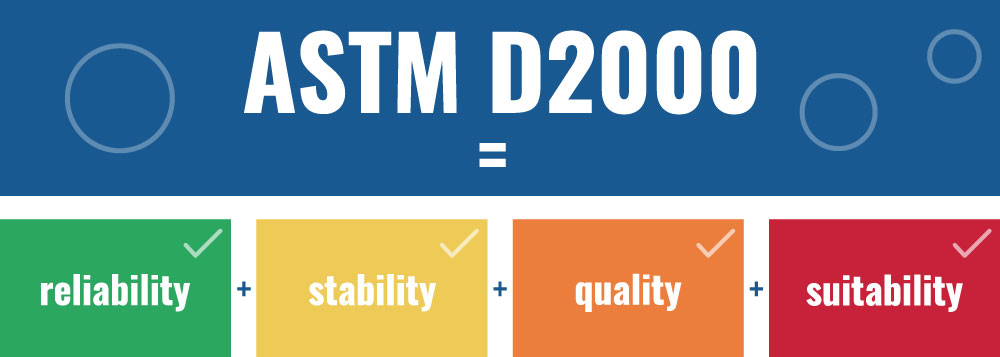
The ASTM D2000 is not merely a standard; it is a practical tool that significantly impacts the daily operations of countless businesses and industries. By following this standard, end users can trust that their sealing compounds are reliable, consistent, and suited to their specific needs.
From the manufacturing floor to the final products, the ASTM D2000 standard influences multiple stages of a product’s lifecycle. Its adherence ensures that products are made with quality in mind and designed for their intended purposes. The performance and durability of these products lead to tangible benefits, such as reduced maintenance costs, increased operational efficiency, and improved safety.
Additionally, the standard serves as a decision-making guide for end users. With the classification system provided by the ASTM D2000, end users can choose products that precisely meet their operational requirements. This ability to make informed choices based on a universally recognized standard ultimately leads to enhanced productivity and overall satisfaction.
However, the impact of the ASTM D2000 extends beyond the immediate use of the product. Ensuring reliability and consistency with products conforming to the standard brings peace of mind to end users. It cultivates a relationship of trust between manufacturers, suppliers, and end users, fostering a culture of reliability and excellence in the sealing industry. Therefore, the ASTM D2000 standard is not just about technical specifications but about enabling businesses to succeed by providing reliable and high-performing products.
Conclusion
In conclusion, the ASTM D2000 standard has profoundly influenced the rubber industry. Its comprehensive classification system and rigorous benchmarks have ensured consistency and high performance in the manufacture and use of sealing compounds. Its universality and adaptability have fostered international cooperation and innovation. As industries continue to evolve and demand for advanced materials increases, the ASTM D2000 will play a critical role.
We at Global O-Ring and Seal view the ASTM D2000 standard as more than a classification system; it’s a promise to our customers that every product we distribute meets the highest quality and performance standards. In a competitive market, our commitment to this standard sets us apart, allowing us to deliver unparalleled value to our customers. Upholding the ASTM D2000 standard is synonymous with maintaining our customers’ trust and confidence in us. For information on a specific compound ASTM D2000 performance, visit our compounds page and view the datasheet for that material. We also offer a complete guide on the ASTM D2000 that aims to break down each segment of an ASTM D2000 call-out.


 English
English  Español
Español  Français
Français  Português
Português  Deutsch
Deutsch  Italiano
Italiano  Русский
Русский  中文
中文  日本語
日本語  العربية
العربية  हिन्दी
हिन्दी 